Address any questions or comments regarding this newsletter to the individual authors listed after each article or to its editors, Nathan Johanning, 618-939-3434, njohann@illinois.edu or Bronwyn Aly 618-695-6060, baly@illinois.edu. The Illinois Fruit and Vegetable News is available on the web at: http://ipm.illinois.edu/ifvn/. To receive or be removed from email notification of new postings of this newsletter, contact Nathan Johanning or Bronwyn Aly at the phone numbers or email addresses above.
In This Issue:
Upcoming Programs ((listings for beginning and established growers))
Regional Reports ((west central, east central, St. Louis metro east, southern Illinois, Dixon Springs))
Fruit & Vegetable Production & Pest Management ((Modified Growing Degree Days from Jan 1 through May 13, Additional Grape Production Videos Online, Insecticide and Miticide Update for Vegetable and Fruit Crops))
Upcoming Programs
Check the Illinois SARE calendar for a full list of programs and links for registration.
http://illinoissare.org/ and http://illinoissare.org/calendar.php
Also see the University of Illinois Extension Local Food Systems and Small Farms Team’s website at:
http://web.extension.illinois.edu/smallfarm/ and the calendar of events at http://web.extension.illinois.edu/units/calendar.cfm?UnitID=629.
- 2019 Southern Illinois Summer Twilight Series Double Star Farms, Monday, May 20, 2019 at 6 p.m. The first Southern Illinois Summer Twilight Meeting will be held at Double Star Farms 16182 Mt. Zion Rd, Benton, IL. Mike Gehman and family will be hosting this meeting, highlighting their aggregation center, marketing, and production of vegetables. The meeting will start at their Benton location and will then move to the farm itself, which is located near Ewing, IL. For more information or to register, please contact Bronwyn Aly, baly@illinois.edu ; 618-252-8391.
- State Horticulture Field Day, Thursday, June 13, 2019, 8 a.m. Tanners Orchard, 740 State Rt. 40 Speer, IL 61479. Sponsored by the Illinois State Horticulture Society. For more details and tickets visit www.buytickets.at/ishs or Contact Charlene Blary at CBlary@ilfb.org or 309-557-2107
- 2019 Southern Illinois Summer Twilight Series Dixon Springs Agricultural Center, Monday, June 17, 2019 at 6 p.m. The second Southern Illinois Summer Twilight Meeting will be held at the University of Illinois Dixon Springs Agricultural Center 354 State Highway 145 N, Simpson, IL 62985. Local Foods/Small Farms Educators, Bronwyn Aly and Nathan Johanning, will be hosting this meeting, highlighting current high tunnel research and demonstration trials and production practices being utilized in the Local Foods Area at DSAC. Dr. Wenjing Guan, Purdue University, will be discussing the ongoing cucumber trial and basic vegetable grafting. For more information or to register, please contact Bronwyn Aly, baly@illinois.edu ; 618-252-8391.
Regional Reports
From west central Illinois (Macomb)… I for one have thoroughly enjoyed spring this year. I know, I may be in the minority, but having some solid cool weather (not hot, not cold) has been great for all the cool season plants. On the other hand, the rain has made preparing for summer crops difficult and delayed a lot of fieldwork. Believe it or not, corn is coming up, that is if the farmers were lucky enough to get to plant during that two-day window a few weeks ago. I will clarify the corn I saw emerging had yellowed leaves.
For those growers that tried to get ahead of the game (me) and planted tomatoes outside without protection, we may be regretting the early planting. Our tomatoes have survived the cool nights, but are not too happy. Our cool nighttime temperatures may not kill my tomato plants, but it will set them back a few weeks. However, the cabbage looks great!
One good thing to review with farm workers are plants that can cause adverse skin reactions. Poison ivy being the obvious culprit. You may know these plants, but many Americans do not recognize them. Don’t assume just because your farm worker has experience, they know what plants can be harmful. Even poison ivy can be a bit tricky sometimes as there are many look-a-likes. Last week I had to instruct people pulling weeds that the plant in their bare hand was wild parsnip, which can cause severe blistering when the sap gets on your skin and is then exposed to the sun. When hand pulling or string trimming weed patches, make sure you and your employees are wearing gloves, long-sleeved shirt, and pants. For more information check out my article on wild parsnip from 2016. In addition, resources on this plant and other plants that cause skin irritation can be found at the bottom of the linked article.

A very unhappy tomato after being planted outdoors and then experiencing some chilly nights. One night we got down to 39 degrees Fahrenheit. We will see how it recovers compared to other transplants that have yet to be set out. Photo: C. Enroth
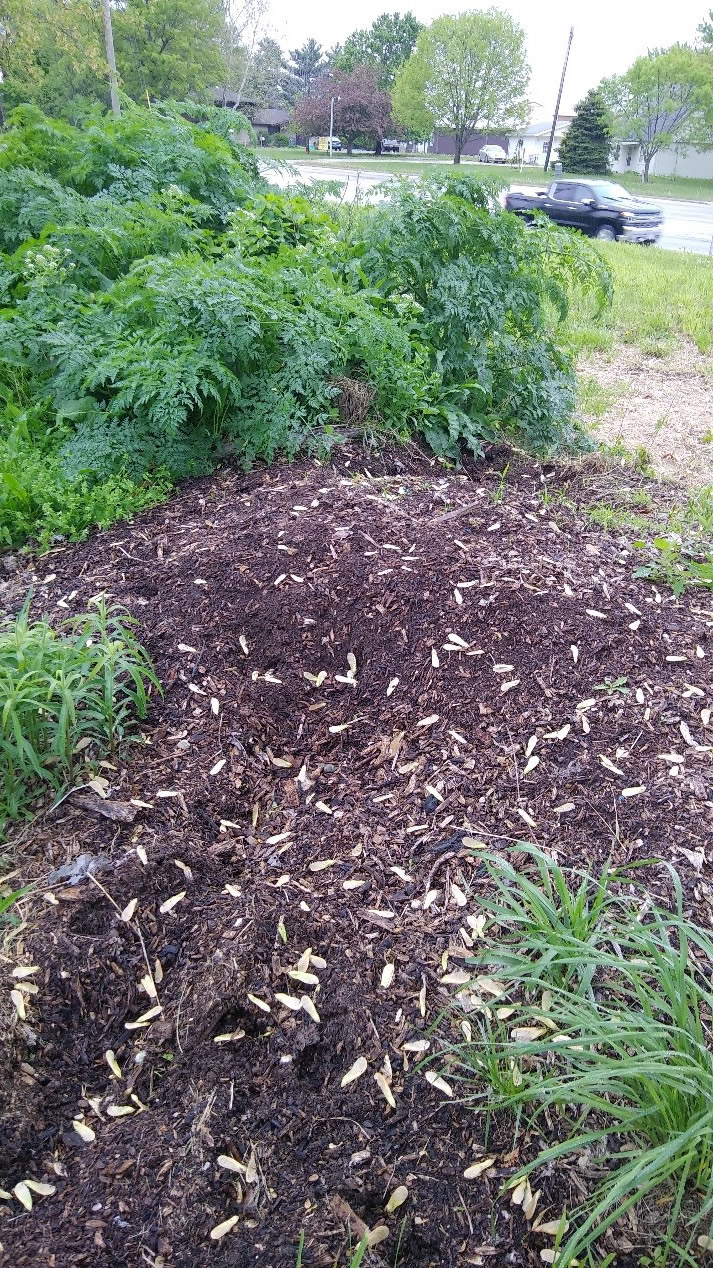
Manure composts can be a haven of weed seeds. Pictured here is a pile of composted horse manure covered in poison hemlock. Dermal reactions have been recorded with this plant, but it is best known for its toxicity when ingested. (It is what they used to kill Socrates) Train your workers to recognize these potential hazards and take appropriate precautions. Photo: C. Enroth
Chris Enroth (309-837-3939; cenroth@illinois.edu)
From East Central…WET. Over most of this area it has been very wet with very little field planting taking place. The exception to that being well drained fields and fields with previously established beds. Due to all the cloudy weather, crops have been growing slowly except for those in high tunnels. Early season cold snap in April did reduce fruit tree blooms in some orchards.
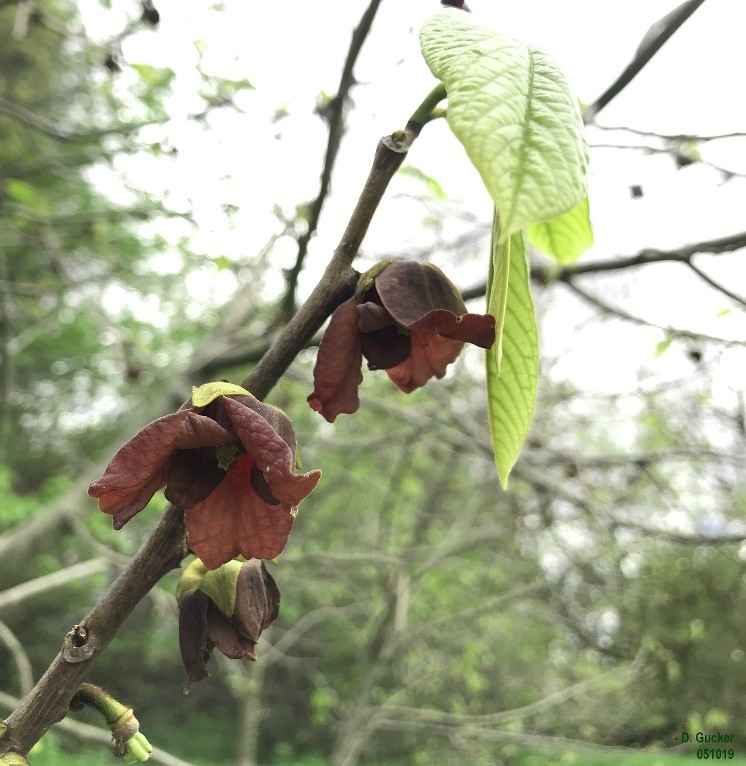
Pawpaws are blooming in the cool, wet weather of central Illinois.
Doug Gucker (217-877-6042; dgucker@illinois.edu)
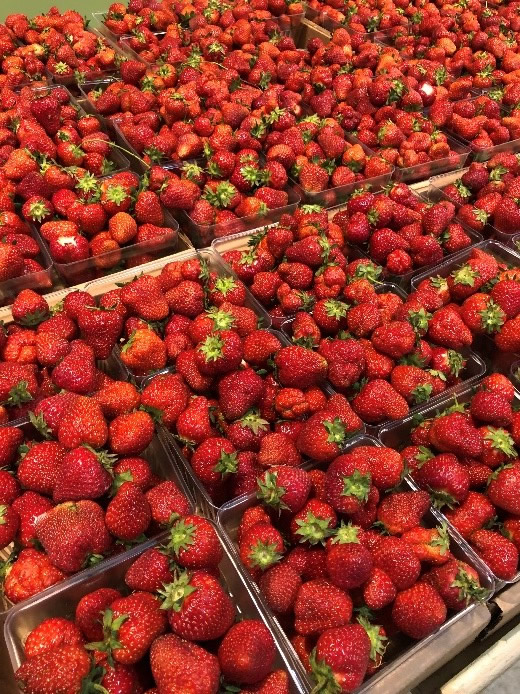
Pawpaws are blooming in the cool, wet weather of central Illinois.
From St. Louis metro-east…The rain continues to fall, leaving only tiny windows to get field work done, but it is getting done for the most part. Tunnel activities for the most part are running uninterrupted. The major delay is field level planting. Growers are also pre-picking more berries and asparagus due to rain keeping u-pick customers away. For strawberries, fruit anthracnose should be in the back of your mind. This is a warm temperature disease, and so far our cooler weather had kept it at bay. With warmer temperature in the forecast, an explosion of fruit anthracnose is a real possibility. Timing of pesticide applications during harvest is critical. Be checking the spray guide for effective products like Quadris Top that have preferentially a 0-1 day pre-harvest interval (PHI). Keep in mind that you have to allow for the restricted entry interval (REI) as well. Quadris Top may have a 0 day PHI, but it has a 12 hour REI. That means anybody entering the field within 12 hours of application would need to wear the label-required personal protective equipment.
Apples look great, though thinning conditions have not been the best. Most are on their second round of thinners…did I mention we need some sunshine. Peaches are sizing and are probably a week out from loosening for the next round of peach thinning. Blackberries look great, all but Prime-Ark 45 which proved again this year that it is a low-chill cultivar, meaning it leafed out way too soon and got zapped by freezing temperatures. Newly planted fruit trees have responded well to the abundant rain and cooler temperatures.
Grapes will be in full bloom within the next two weeks, so this is the time to focus of diseases that affect clusters, specifically black rot, powdery mildew, anthracnose and downy mildew. Mancozeb (77 PHI) is the best backbone fungicide at this time, but it is weak on powdery mildew so it needs to be tank mixed with an effective powdery mildew product, like Rally or Abound.
Staking and twining of field tomatoes has started. Horseradish is still being dug and sweet corn plantings are being squeezed in. I have received several reports of evening activities just to take advantage of any and all dry field conditions. Hard to believe with this slow warm-up that we are only a couple weeks away from the first pumpkin plantings.
Elizabeth Wahle (618-344-4230; wahle@illinois.edu)
From southern Illinois... Still wet! Like many if not most across the state, it is still very wet in southern Illinois. We had about a 0.3 inch of rain over the weekend and a half inch early Wednesday morning. This doesn’t sound like a lot for this time of year but when the ground is beyond saturated it just about could have been 2 inches and we would still be just as wet. This has been coupled with very cool temperatures over the weekend barely 60˚ and no over abundance of sun some days which has meant that the soil is very slow to dry. Looking ahead there are still some rain chances in the forecast, but finally we have highs predicted for the upper 70s to mid 80s for the better part of the next week. This will help dry the soil considerably especially if we have some wind as well. There have only been a few days this year that we have even gotten up to 80˚ which is unusual to say for it now being mid-May.
We are starting to wind down aspargus harvest on our variety trial. We are now into the 6th week of harvest and depending on the weather and growth may go another week or so. Harvests have been slow and steady for the most part. With moderate to cool temperatures we haven’t had any “big” harvests like we would after a warm weekend. This has been good for spear quality as for the most part spears have stayed nice and tight. I feel like the long stretch of saturated soil is taking its toll as well, but hopefully that will change.
I did have a chance finally to cultivate my potatoes at home. They have been planted a little over a month and are abour 8-10 inches tall and I have probably the best stand I have had in many years. The weeds were soon going to be getting out of control if they weren’t cultivated soon. It was really wetter than I would like, but it didn’t work too bad. This can be a major issue if it didn’t dry out and the weeds got larger and cultivation wasn’t effective. So what can you do to if you couldn’t cultivate because of the weather? It is a good time to consider preemergnce herbicides for the next season. If I had a pre emergence herbicide like Reflex or Dual Magnum down on my potatoes that would have significantly decreased the weed pressure, reducing the pressure on me to take action. Ok so what can you do about this year’s crop? Shielded sprays of a contact herbicide either by hand or tractor would be an option to help reduce the weeds especially between rows. The last resort or default option might be to wait and cultivate when you can, knowing that you will probably have more oeing/handweeding to do to clean things up. Also, note that for the grass weeds that may escape cultivation in this situation you can spray a grass herbicide postemergence to manage those weeds.
Hopefully soon our weather pattern will shift a little more in our favor!
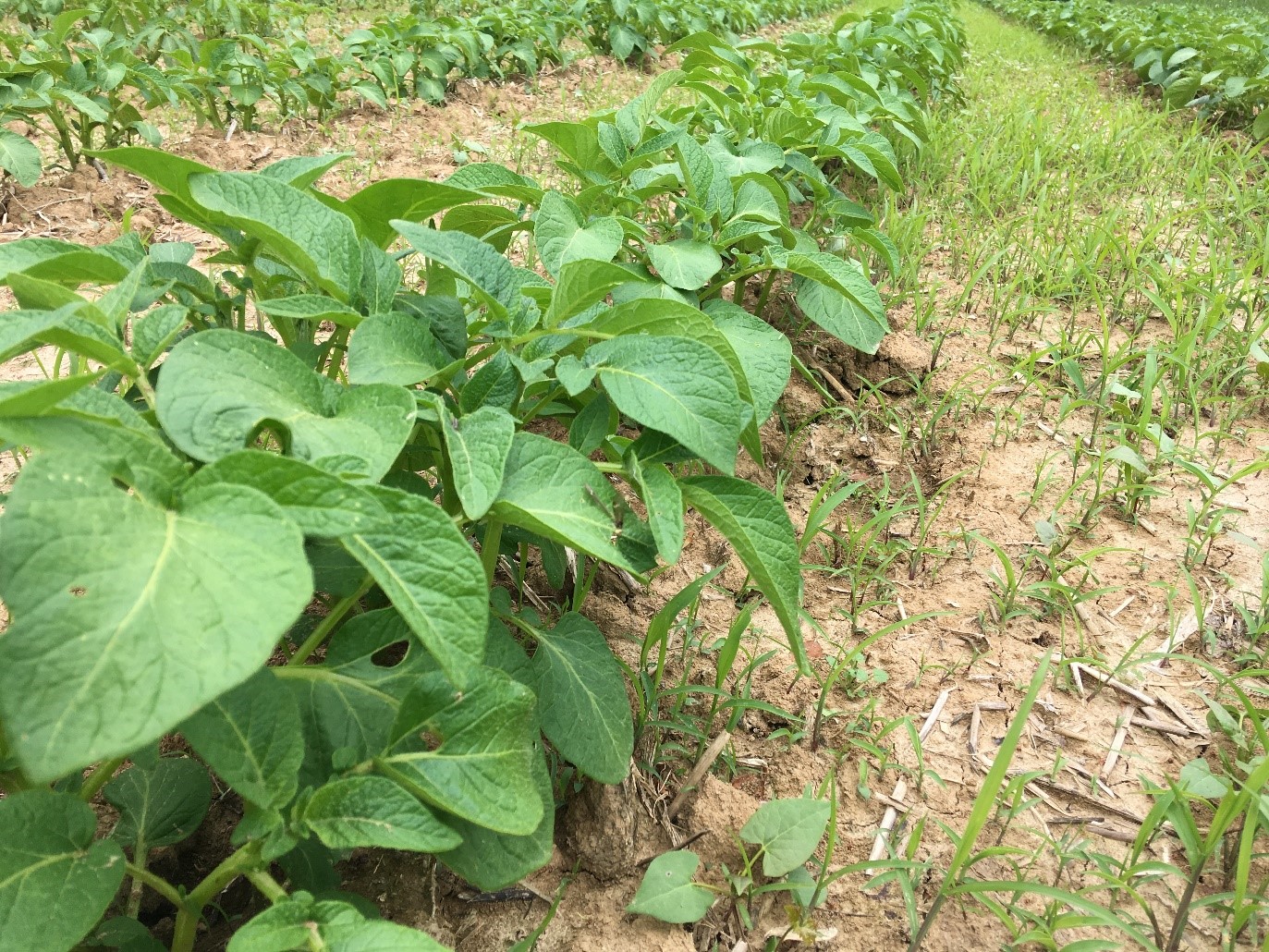
Potatoes prior to cultivation. The wet weather has made it a challenge to make timely cultivation of crops. Photo: N. Johanning
Nathan Johanning (618-939-3434; njohann@illinois.edu)
From Dixon Springs Ag Center…We have been battling aphids in both high tunnels and the greenhouse but have finally cleared them up. No other insect pests have been seen thus far. Determinate tomatoes have all been pruned, staked, and most have the second string in place. We have already seen small green fruit and several of the tomato varieties. Peppers seem to be growing really hard and are about ready to set their first blooms. Cucumber harvest is now steady, with a pick schedule of every Monday, Wednesday, and Friday. Cut flowers are starting to bloom and herbs are filling in, with some already needing to be cut. Harvesting the first batch of hydroponic lettuce, with the second planting well on its way, and third planting seeds have sprouted and will be moved into the NFT system next week. The first flush of strawberries have been harvested from the hydroponic stacks. The fruit quality was excellent, firm and flavorful. I did note that letting the fruit hang one more day, getting the deep red, almost overripe look, allowed the fruit to develop its flavor. While it was sometimes hard to let the fruit go that extra day, the firmness held up, making for great quality fruit. This first flush yielded close to 1/10 of a pound per plant with the next round of flowers starting to bloom.
Hydroponic lettuce, strawberries, and cucumbers being grown in one of the high tunnels at DSAC. Photos: Bronwyn Aly.
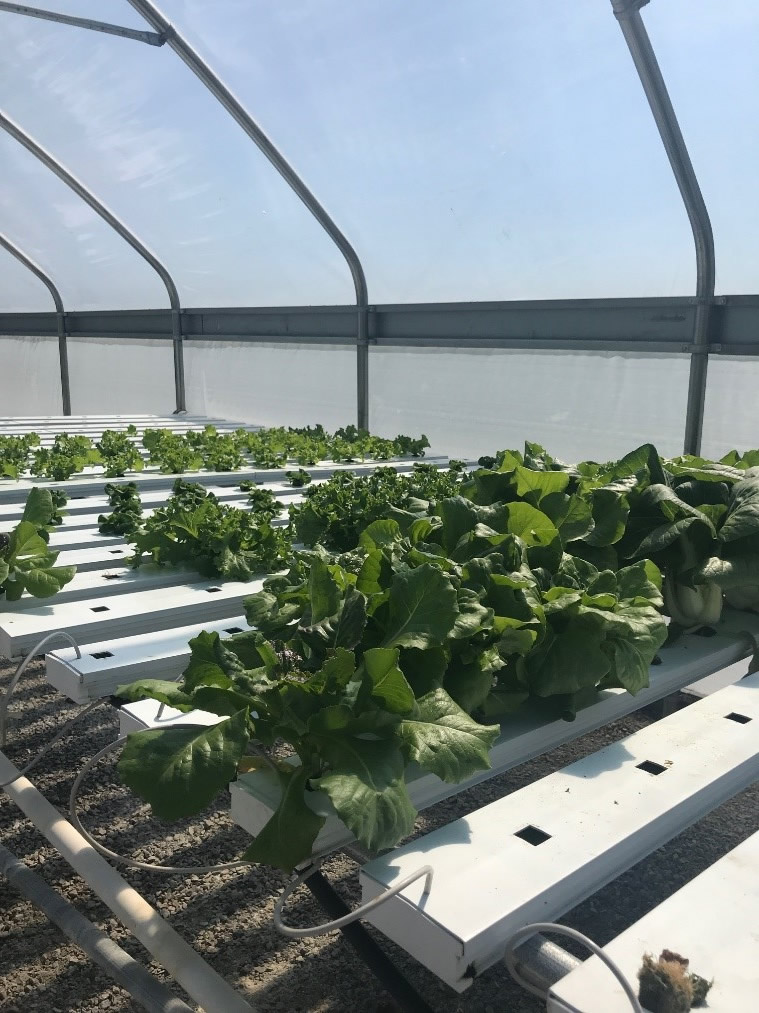
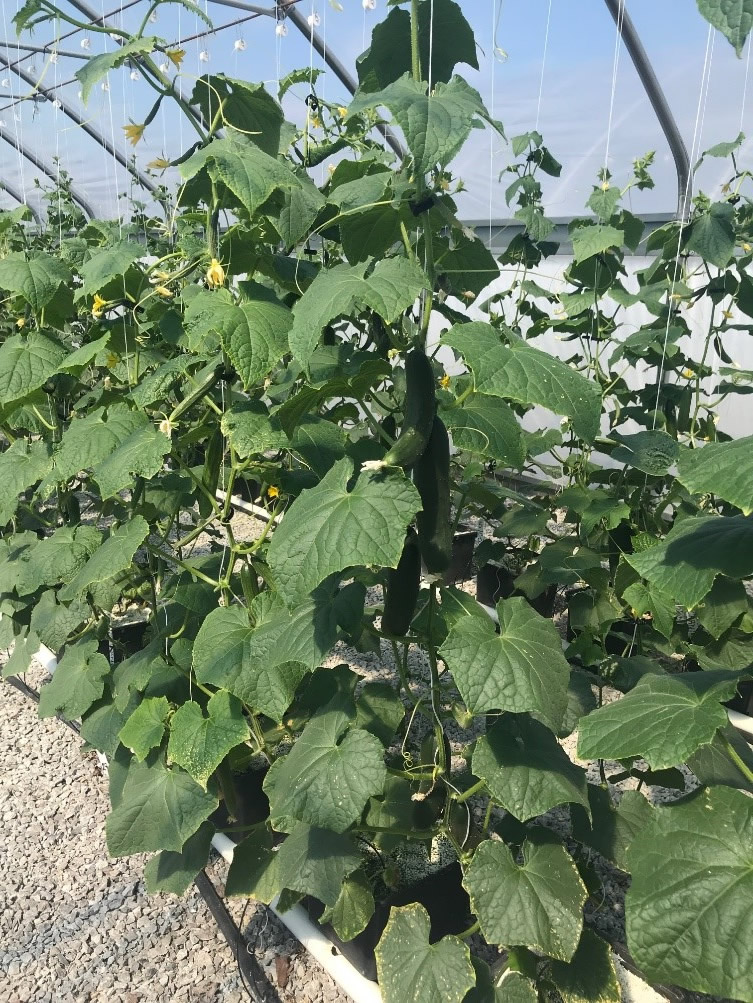
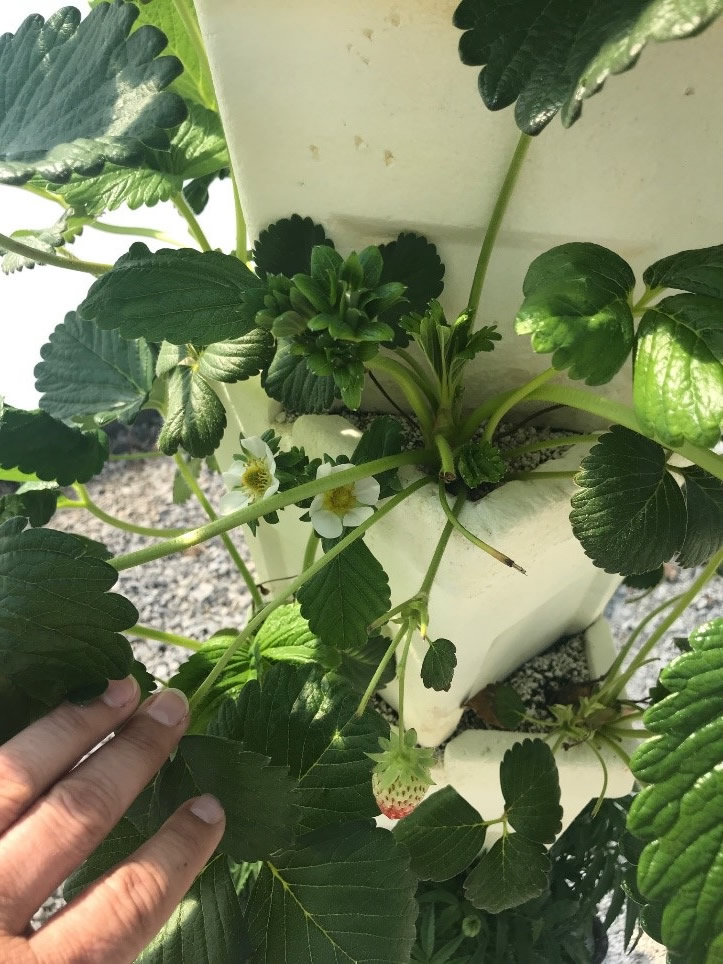
The Southern Illinois Summer Twilight Meeting for June will be held at the Dixon Springs Agricultural Center. If you are interested in seeing hydroponic production of various crops as well as raised bed, in ground vegetable high tunnel production, you are encouraged to attend the meeting. Dr. Guan from Purdue University will be discussing her cucumber trial, DSAC is one of 3 sites conducting this trial, as well as vegetable grafting.
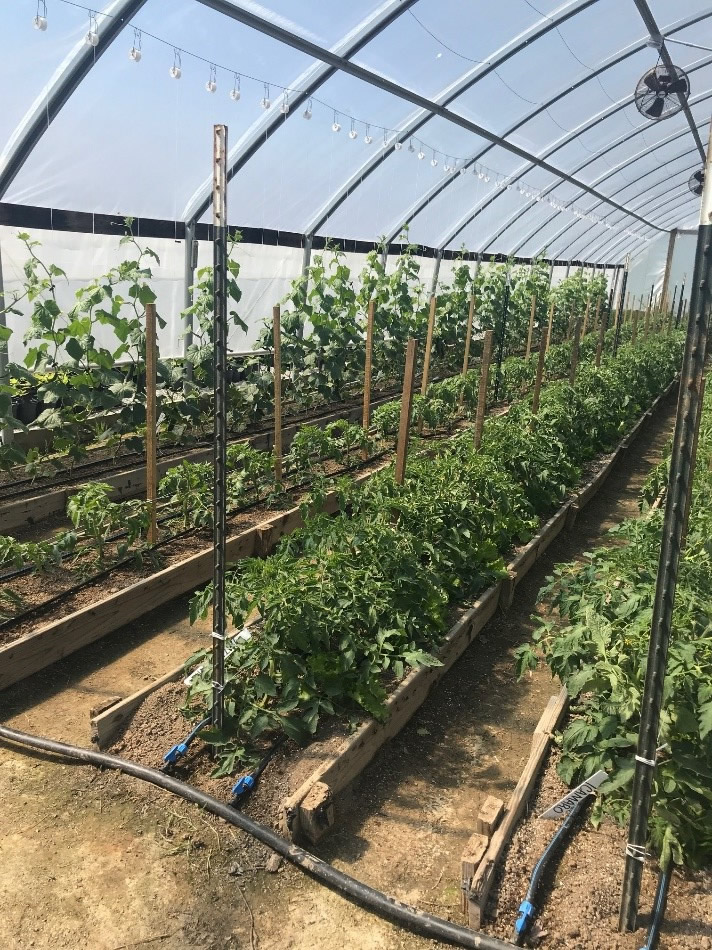
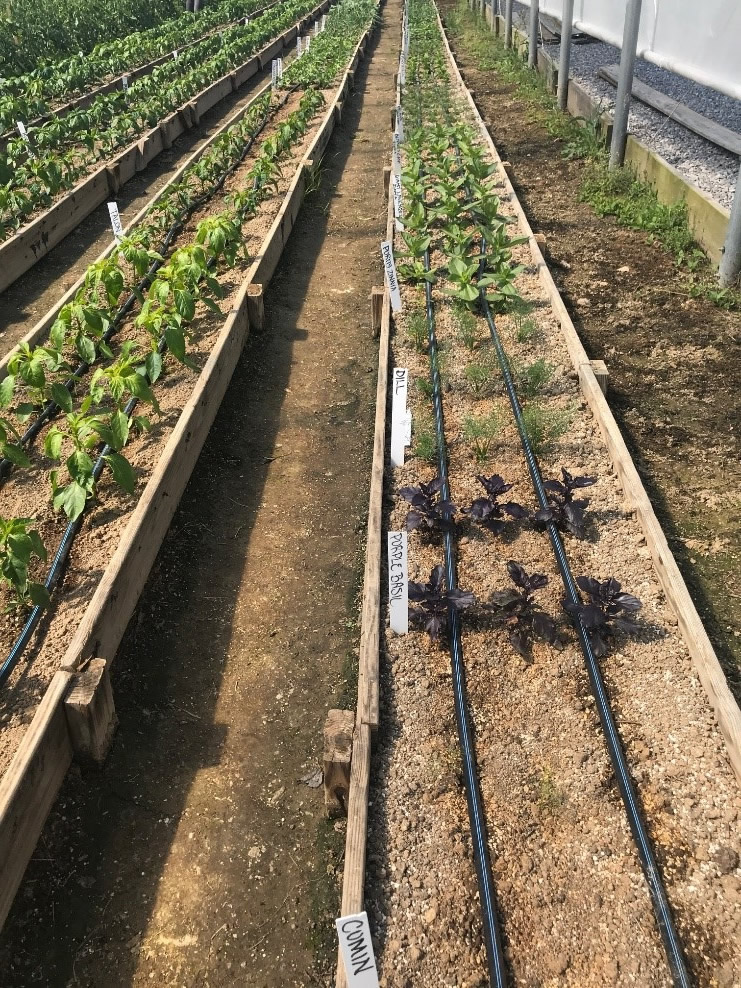
Determinate tomatoes, peppers, herbs, and cut flowers being grown in one of the high tunnels at DSAC. The cumin does not seem to like our growing conditions. Photos: Bronwyn Aly.
Bronwyn Aly (618-382-2662; baly@illinois.edu)
Fruit & Vegetable Production & Pest Management
Modified Growing Degree Days (Base 50⁰ F, January 1 through May 13)
Station Location |
Actual Total |
Historical Average (11 year) |
One- Week Projection |
Two-Week Projection |
Freeport |
188 |
270 |
259 |
334 |
St. Charles |
186 |
263 |
252 |
321 |
DeKalb |
173 |
300 |
249 |
331 |
Stelle |
238 |
349 |
320 |
406 |
Peoria |
289 |
386 |
375 |
460 |
Monmouth |
245 |
350 |
330 |
414 |
Champaign |
348 |
390 |
438 |
530 |
Springfield |
384 |
439 |
484 |
585 |
Perry |
382 |
430 |
473 |
563 |
Brownstown |
424 |
507 |
526 |
632 |
Olney |
460 |
493 |
558 |
662 |
Belleville |
520 |
543 |
626 |
735 |
Rend Lake |
541 |
591 |
652 |
768 |
Carbondale |
559 |
569 |
661 |
771 |
Dixon Springs |
616 |
626 |
725 |
840 |
Insect development is temperature dependent. We can use degree days to help predict insect emergence and activity. Degree day accumulations calculated using the Pest Degree-Day Calculator
Kelly Estes, State Survey Coordinator, Illinois Cooperative Agricultural Pest Survey (217-333-1005; kcook8@illinois.edu)
Additional Grape Production Videos Online
Brad Taylor and I have created four additional in-season YouTube videos for commercial grape production, and will have more to come.
Grape Canopy Management – Diseases and Shoot Thinning https://youtu.be/n6Rk5bedPkM
2019 Early-season Vineyard Weed Management - Part 1 https://youtu.be/hGzofF0C6XA
2019 Early-season Vineyard Weed Management - Part 2 https://youtu.be/K1VZhQisIfA
2019 Weed Management in the Vineyard - Part 3 https://youtu.be/_cLnIIeNXA8
2019 Assessing Grape Vine Vigor https://youtu.be/5wg8KCfAStg
2019 Grape Phylloxera and Boron Bloom Sprays https://youtu.be/vpu_a9WCx0M
Elizabeth Wahle (618-344-4230; wahle@illinois.edu)
Insecticide and Miticide Update for Vegetable and Fruit Crops.
The following information from The Ohio State University VegNet Newsletter (April 24, 2019 & May 4, 2019) has been included by permission from the author, Celeste Welty, an Extension Entomologist from The Ohio State University. https://u.osu.edu/vegnetnews/2019/04/ https://u.osu.edu/vegnetnews/2019/05/04/insecticide-update-for-vegetable-and-fruit-crops/
There have been a few insecticide registrations that have come through since previous updates this past winter (summaries from January are available with these links: https://cpb-us-w2.wpmucdn.com/u.osu.edu/dist/1/8311/files/2019/02/PAT_Jan2019_1-page-1hvqfhg.pdf and https://cpb-us-w2.wpmucdn.com/u.osu.edu/dist/1/8311/files/2019/02/Summary_Jan2019_1-page-22nf965.pdf ).
Torac and Apta from Nichino America both contain tolfenpyrad as the active ingredient; both are in IRAC’s mode-of-action group 21A. Since March 2019, new crops on the new Torac label are onions and other bulb vegetables, lettuce and other leafy vegetables, and celery and other leaf petiole vegetables. Torac controls thrips, aphids, leafhoppers, flea beetles, and some caterpillars. Since February 2019, new crops on supplemental labels for Apta are strawberry and other low growing berries, raspberries and other caneberries, and blueberries and other bushberries. Apta controls thrips, plum curculio, fruitworms, Lygus (tarnished plant bug), and suppresses spotted-wing Drosophila.
Versys is a new insecticide from BASF that contains afidopyropen as the active ingredient, which puts it in IRAC group 9D. On the initial label in October 2018, the target pests were only aphids, as controlled at a low rate of product. A newer label now includes control of whiteflies at a higher rate of product.
Exirel is now allowed on raspberries and other caneberries, as shown on a supplemental label from November 2018. Use on caneberries is with a 1-day pre-harvest interval, for control of spotted-wing Drosophila and adult root weevils. Exirel is from FMC, contains cyantraniliprole as the active ingredient, in IRAC group 28.
PQZ is a new insecticide product from Nichino America that has been registered since 2018 but was missed in our earlier updates. PQZ contains pyrifluquinazon as the active ingredient. It is in IRAC group 9B. It controls aphids, whiteflies, and leafhoppers, and is allowed for use on Brassica head and stem vegetables, cucurbits, fruiting vegetables, leaf petiole vegetables, leafy vegetables, tuber and corm vegetables, as well as on pome fruit, stone fruit, and grapes.
Ethos-3D is a new insecticide/fungicide product from FMC that has been registered since 2018 but was missed in our earlier updates. It is for use on sweet corn. It contains bifenthrin (the same AI as in Brigade; IRAC group 3A) as the insecticidal component, and Bacillus amyloliquefaciens as the fungicidal component. It is for application at-planting for control of corn rootworm larvae, Asiatic garden beetle, wireworms, grubs, seedcorn maggot, cutworms, and armyworms.
Magister, a new miticide, has expanded registration.
Magister SC Miticide from Gowan Company is now registered for use on many specialty crops. Although it is called a miticide because it controls spider mites and rust mites, it also controls some insects (psyllids and whiteflies), and powdery mildew on some crops. The active ingredient is fenazaquin. It is in mode-of-action group as a miticide is 21A, the same group that contains Nexter, Portal, Torac, and Apta. Magister kills mite eggs by contact, and kills mite adults and immatures by contact and ingestion. For fungicidal activity, it is in FRAC group 39. Magister is highly toxic to bees, so care must be taken to not spray it on blooming crops or weeds.
Magister has been registered for a few years for use only on hops and cherries. Vegetable crops now on the label are cucurbits (3-day PHI), fruiting vegetables (3-day PHI), and legumes (7-day PHI). Small fruit crops now on the label are blueberries (7-day PHI), caneberries (7-day PHI), strawberries (1-day PHI), and grapes (7-day PHI). Tree fruit crops now on the label are pome fruit (7-day PHI) and stone fruit (3-day PHI). Hops are also on the label (7-day PHI). The label specifies a limit of one application per year on each crop, and a 12-hour re-entry interval. The rates are 24-36 or 32-36 fl oz per acre, depending on crop.
Celeste Welty, Extension Entomologist, Ohio State University (614-292-2803; welty.1@osu.edu) Ohio VegNet News https://u.osu.edu/vegnetnews
Connie Echaiz (847-223-8627; cechaiz@illinois.edu)
Less Seriously
- I told my wife she was drawing her eyebrows too high. She looked surprised.
- I threw a boomerang a few years ago. I now live in constant fear.
- Someone stole my mood ring, I don’t know how I feel about that.
- I broke my finger last week. On the other hand, I’m okay.
- I tried to catch fog yesterday, mist.
- Working in a mirror factory is something I can actually see myself doing.
- What’s the difference between a well dressed man on a bike and a poorly dressed man on a unicycle? Attire.
- My grandfather has the heart of a lion and a lifetime ban at the zoo.
- Someone stole my Microsoft Office and they’re gonna to pay. You have my Word.
- “Just say NO to drugs!” “Well, if I’m talking to my drugs…I probably already said yes.”
University of Illinois Extension Specialists in Fruit and Vegetable Production & Pest Management
Extension Educators – Local Food Systems and Small Farms |
||
Bronwyn Aly, Gallatin, Hamilton, Hardin, Pope, Saline, and White counties |
618-382-2662 |
|
Katie Bell, Franklin, Jackson, Perry, Randolph, & Williamson counties |
618-687-1727 |
|
Sarah Farley, Lake & McHenry counties |
847-223-8627 |
|
Nick Frillman, Woodford, Livingston, & McLean counties |
309-663-8306 |
|
Laurie George, Bond, Clinton, Jefferson, Marion, & Washington counties |
618-548-1446 |
|
Zachary Grant, Cook County | 708-679-6889 | |
Doug Gucker, DeWitt, Macon, and Piatt counties |
217-877-6042 |
|
Erin Harper, Champaign, Ford, Iroquois, and Vermillion counties |
217-333-7672 |
|
Grace Margherio, Jackie Joyner-Kersee Center, St. Clair County |
217-244-3547 |
|
Grant McCarty, Jo Daviess, Stephenson, and Winnebago counties |
815-235-4125 |
|
Katie Parker, Adams, Brown, Hancock, Pike and Schuyler counties |
217-223-8380 |
|
Kathryn Pereira, Cook County |
773-233-2900 |
|
James Theuri, Grundy, Kankakee, and Will counties |
815-933-8337 |
|
Extension Educators – Horticulture |
||
Chris Enroth, Henderson, Knox, McDonough, and Warren counties |
309-837-3939 |
|
Richard Hentschel, DuPage, Kane, and Kendall counties |
630-584-6166 |
|
Andrew Holsinger, Christian, Jersey, Macoupin, & Montgomery counties |
217-532-3941 |
|
Extension Educators - Commercial Agriculture |
||
Elizabeth Wahle, Fruit & Vegetable Production |
618-344-4230 |
|
Nathan Johanning, Madison, Monroe & St. Clair counties |
618-939-3434 |
|
Campus-based Extension Specialists |
||
Kacie Athey, Entomology |
217-244-9916 |
|
Mohammad Babadoost, Plant Pathology |
217-333-1523 |
|